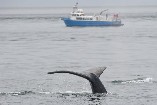Are Humpback Whales Off the Endangered Species List? Not Quite!

Earlier this year the National Oceanic and Atmospheric Administration (NOAA) proposed the removal of two-thirds of the world’s humpback whale population from the endangered species list. Humpbacks became endangered in 1970 and after 45 years of conservation some populations are showing signs of making a comeback. NOAA estimates that the West Indies population of humpback whales is growing at the rate of 2% per, while the East Australia population is growing at the rate of 11% per year. However not all humpbacks populations are growing. Some communities, including Panama’s whales, still face environmental dangers such as vessel collision and fishing net entanglements that threaten their existence.
To deal with the problem, NOAA has proposed to divide the world’s humpbacks into 14 distinct population segments (DPS). Humpbacks travel in communities. Each population with the same migration pattern feeds together and has a unique song. The proposed division will help NOAA, better study and protect the animals. It would allow for some segments to be delisted, while others continue to benefit from species protection. Panama’s DPS will remain as “threatened” on the Species List.
According to NOAA documents, it is thought there are about 500 humpbacks that travel through Central America. This number comes as a surprise, as sources talking about humpbacks in Panama, usually quote about 2000 mammals.
Humpback whales make long journeys and are capable of travelling at speeds of 25 km/h or more, however during migration they move slowly, resting and socializing along the way. Generally they spend the winter in warm, tropical waters breeding and giving birth, and the spring, summer and autumn feeding in cool, polar waters. The humpbacks which feed in Antarctic waters, and breed in Columbia and Panama make the longest confirmed migration of any mammal.
Delisting a species helps show the effectiveness of protection and conservation. It also loosens requirements for commercial activities. Federal approval is required before undertaking any activity that might harm an endangered species. Last year Alaska filed a petition with the NOAA to delist certain subspecies of whales. Doing so will enable companies that want to explore the Arctic Coast for oil.
NOAA Fisheries opened the delisting proposal for a 90-day public comment period. The process of removing the whales from the endangered species list will take about a year. You may go online and join in the delisting conversation at:
http://www.regulations.gov/#!submitComment;D=NOAA-NMFS-2015-0035-0018
Even if the proposal takes effect, delisted humpback populations in U.S. waters would still be protected under the Marine Mammal Protection Act, and internationally under the International Whaling Commission's global moratorium on commercial whaling.
